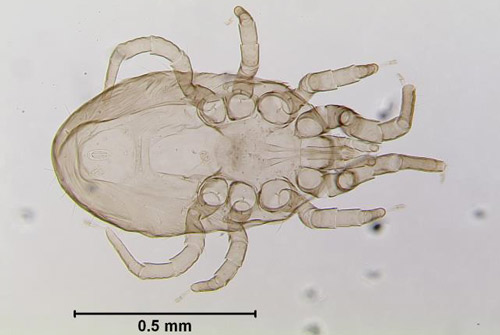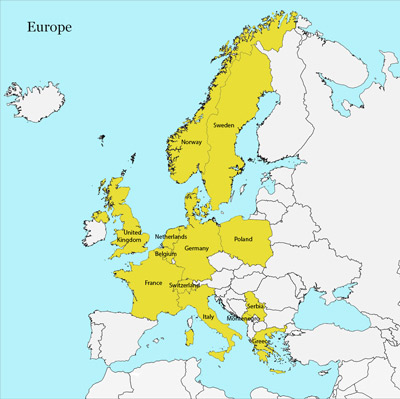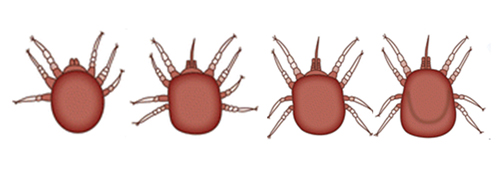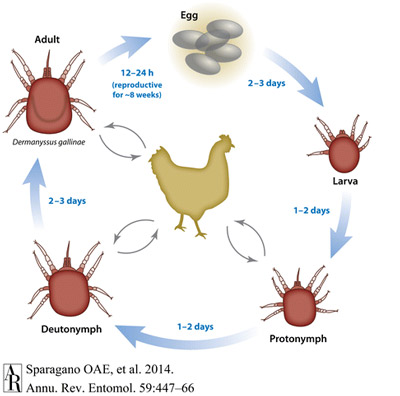common name: chicken mite (other common names: poultry red mite, roost mite)
scientific name: Dermanyssus gallinae (De Geer) (Arachnida: Acari: Dermanyssidae)
Introduction - Distribution - Description - Life Cycle - Hosts - Economic Importance - Survey and Detection - Management - Selected References
Introduction (Back to Top)
The chicken mite, Dermanyssus gallinae (De Geer) (Figure 1), is a parasitic poultry mite that is widely distributed. Despite its common names (poultry red mite and roost mite), Dermanyssus gallinae has a large range of hosts including several species of wild birds and mammals (Sparagano et al. 2014). In both size and appearance, it resembles the northern fowl mite, Ornithonyssus sylviarum (Canestrini and Fanzago), which is abundant in the United States (Chauve 1998). Chicken mites hide in nests, cracks, crevices, and litter when they are not feeding.
Figure 1. Adult chicken mite, Dermanyssus gallinae (De Geer). Photograph by Lyle J. Buss, University of Florida.
Distribution (Back to Top)
Chicken mites are distributed worldwide. In many countries, Dermanyssus gallinae poses a threat to birds used for meat and egg production. They are found in many areas including Europe, Japan, China, and the United States. In the United States, Dermanyssus gallinae is rarely found in caged-layer operations and is more commonly found in breeder farms (Ruff 1999). Although Dermanyssus gallinae affects birds in many regions, it is most prevalent in European countries (Figure 2).
Figure 2. European countries are marked in yellow if they have documented presence of the chicken mite, Dermanyssus gallinae (De Geer). Map by Ethan Carter.
Description (Back to Top)
Dermanyssus gallinae is an ectoparasite (lives or feeds on exterior of the host) that typically feeds at night (Sparagano et al. 2014). It does not stay on the bird at all times, and rarely feeds during the day. The adult measures about one millimeter long (Roberts 2013). After feeding, adults are red, but look black, grey or white without host blood in their system (Hoy 2011). Aside from the egg, the chicken mite has four stages in its life cycle: the larva, protonymph, deutonymph, and adult (Figure 3) (Sparagano et al. 2014). Larvae hatch with six legs and do not feed (Axtell 1999). After the first molt, both nymphal stages have eight legs, as do the adults. The protonymph, deutonymph, and adult females routinely feed on host blood, while males only feed occasionally (Chauve 1998).
Figure 3. Illustration of the chicken mite, Dermanyssus gallinae (De Geer) at various life stages. Left to right- six-legged larva, and eight-legged protonymph, deutonymph, and adult. Illustration adapted from Sparagano et al. 2014.
Life Cycle (Back to Top)
Although the chicken mite is similar in appearance to the northern fowl mite, Ornithonyssus sylviarum (Canestrini and Fanzago), their life cycles differ in that the chicken mite does not spend its entire life on the host. Chicken mites lay eggs where they hide, in areas such as cracks, crevices, and litter. Females lay eggs in clutches of four to eight, generally laying around 30 eggs in their lifetime (Chauve 1998). After hatching, the six-legged larvae are sluggish, and molt after one day. The eight-legged protonymph feeds and molts to an eight-legged deutonymph, which then feeds and molts to an adult. The entire cycle can be completed in as few as seven days (Figure 4). Removing the host from an area will not eliminate the mites. The deutonymph and adult are known to resist desiccation and live as long as eight months without feeding (Chauve 1998).
Figure 4. The life cycle of the chicken mite, Dermanyssus gallinae (De Geer). Illustration from Sparagano et al. 2014.
Hosts (Back to Top)
Dermanyssus gallinae is primarily considered a pest of chickens. However, it feeds on at least 30 species of birds including pigeons, sparrows, rock doves, and starlings (Sparagano et al. 2014, Proctor and Owens 2000). It has also been known to feed on horses, rodents, and humans (Sparagano et al. 2014).
Economic Importance (Back to Top)
The chicken mite affects egg-laying hens in many parts of the world. In the European Union, egg industry losses associated with production and the control of Dermanyssus gallinae is estimated at €130 million ($177 million) per year (George et al. 2009). Dermanyssus gallinae is a known vector (transmitter) for the St. Louis encephalitis virus and has been linked to other illnesses as well (Chauve 1998). The mites spread other illnesses such as fowl pox virus, Newcastle virus, and fowl cholera (Hoy 2011).
Survey and Detection (Back to Top)
Flocks with infestations of Dermanyssus gallinae are known to have symptoms including anemia, increased stress levels, altered sleep patterns, or feather pecking (Sparagano et al. 2014). Dermanyssus gallinae are rarely seen on the birds because they typically feed at night. The birds must be examined closely at night to see the mites, or mites can be searched for in the nests, cracks, and litter. It is important to remember that the mite is small in size, which makes it difficult to see from a distance. Chicken mites feed every two to four days and usually spend up to an hour on the host (Mul et al. 2009). Infected birds will have lesions that are sometimes visible on the breast and legs as a result of feeding (Axtell 1999).
Management (Back to Top)
Poultry infested with Dermanyssus gallinae are typically treated with synthetic acaricides (mite pesticides) to reduce or eliminate the mite from the flock. There are over 35 compounds that have been used to treat for chicken mite infestations, but many countries now restrict which acaricides can be used for management due to regulations involving active ingredients. Another problem that has surfaced is that of chicken mite populations that are resistant to acaricides, making management more challenging. The return of caged poultry to outdoor, free-roaming systems has made infestations more common.
Manually cleaning equipment and areas that poultry come into contact with (houses, roosts, nests, etc.) will help reduce mite populations. Some producers use heat as a control. In Norway, chicken houses are commonly heated to 45°C (113°F), which kills the mites (Sparagano et al. 2014). As stated previously, removing birds for an extended period of time will not eliminate the mites, as they have been shown to survive up to eight months without feeding (Chauve 1998).
Selected References (Back to Top)
- Axtell R. 1999. Poultry integrated pest management: Status and future. Integrated Pest Management Reviews 4: 53-73.
- Chauve C. 1998. The poultry red mite Dermanyssus gallinae (De Geer, 1778): Current situation and future prospects for control. Veterinary Parasitology 73: 239-245.
- George D, Smith T, Shiel R, Sparagano O, Guy J. 2009. Mode of action and variability in efficacy of plant essential oils showing toxicity against the poultry red mite, Dermanyssus gallinae. Veterinary Parasitology 161: 276-282.
- Hoy MA. 2011. Agricultural acarology: Introduction to integrated mite management. CRC Press, Boca Raton, FL, pp. 325-327.
- Mul M, Niekerk V, Chirico J, Maurer V, Kilpinen O, Sparagano O, Thind B, Zoons J, Moore D, Bell B, Gjevre A, Chauve C. 2009. Control methods for Dermanyssus gallinae in systems for laying hens: Results of an international seminar. World's Poultry Science Journal 65: 589-600.
- Proctor H, Owens I. 2000. Mites and birds: Diversity, parasitism and coevolution. Trends in Ecology and Evolution 15: 358-364.
- Roberts V. (2014). Diseases of farmyard poultry part 4 - External and internal parasites of chickens. National Animal Disease Information Service. http://www.nadis.org.uk/bulletins/diseases-of-farmyard-poultry/part-4-external-and-internal-parasites-of-chickens.aspx. Retrieved July 15, 2014.
- Ruff M. 1999. Important parasites in poultry production systems. Veterinary Parasitology 84: 337-347.
- Sparagano O, George D, Harrington D, Giangaspero A. 2014. Significance and control of the poultry red mite, Dermanyssus gallinae. Annual Review of Entomology 59: 447-466.



